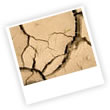The Aral Sea: a disappearing lake

The Secretary General of the United Nations, Ban Ki-Moon, has described the depletion of the Aral Sea as “one of the planet’s most shocking environmental disasters.” Once one of the largest lakes on our planet, it has steadily dried up over the last 50 years, leaving behind desolated expanses of salty sand.
The Aral Sea began shrinking in the 1960s, when the former Soviet Union decided to divert large quantities of water from the rivers which feed it to irrigate cotton fields in Uzbekistan. Since then, the lake has shrunk by 70% and its water has become increasingly saline, contributing to the desertification of the surrounding area and the collapse of the local fishing industry.
“This is a vivid testament to what happens when we waste our common natural resources, when we neglect the environment, when we mismanage our environment,” declared Ban Ki-Moon during his visit to five nations bordering the Aral Sea basin, in a bid to launch an international joint effort on this issue. “I urge all the leaders (of Central Asia) to sit down together and try to find solutions.”
Currently the Aral Sea is split into two distinct bodies. Small Aral in the north is separated from Large Aral in the south by a large dam, completed in 2005, which is part of a broader project for the environmental restoration of the area. Its waters are now cleaner and less saline, allowing the reintroduction of fish species which had disappeared from the lake. The surface of Small Aral has also risen, from 2550 km² to 3300 km².
In Large Aral a project is being implemented to reverse the desertification caused by the evaporated lake, by planting vegetation which is tolerant of highly saline environments. According to some experts however, there may be also be an attempt to restore original water levels in this area, for example by building an aqueduct with a desalination plant connected to the Caspian Sea. Perhaps one day the Aral Sea will come back to life?





